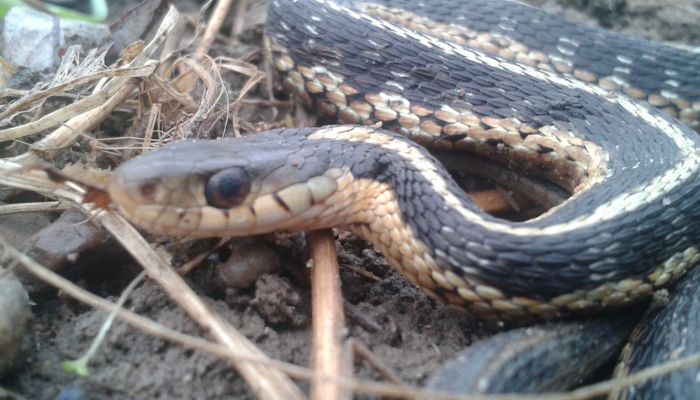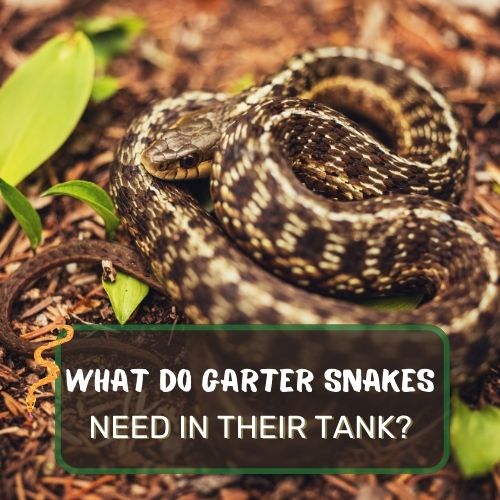Ever wondered where garter snakes vanish to during the chilly winter months? Dive into the fascinating world of these slithery creatures as we unravel the mystery of their hibernation habits.
Garter snakes hibernate, or more accurately, brumate, for several months during colder periods. Typically, they begin their dormancy from late October and emerge around March or early April. The exact duration can vary based on regional temperatures and specific environmental conditions.
From understanding the difference between brumation and hibernation to exploring the social dynamics of their winter hideouts, this article delves deep into the hows and whys of garter snake dormancy.
We’ve also tackled some burning questions to satisfy your curious mind. Ready to embark on this serpentine journey?
Let’s slither in!

Table of Contents
Why Do Garter Snakes Hibernate?
If you’ve ever stumbled upon these slithery creatures during the warmer months and then wondered where they vanish to when the cold sets in, you’re not alone. Let’s unravel this mystery together.
Survival Mechanism During Colder Months
Imagine you’re a garter snake. The sun is shining, the grass is green, and you’re out and about, enjoying the warmth. But as the days get shorter and the temperature drops, things start to change.
You’re cold-blooded, which means you rely on the environment to regulate your body temperature. So, when winter approaches, staying active becomes a challenge. The ground gets cold, food becomes scarce, and suddenly, the world isn’t as friendly as it used to be.
This is where hibernation, or more accurately, brumation, comes into play. It’s a survival mechanism. By going into a state of dormancy, garter snakes can protect themselves from the harsh external conditions.
It’s like their version of cozying up with a blanket and hot cocoa, except they’re tucked away in a safe spot, waiting for spring.
Energy Conservation
Now, let’s talk energy. Everything we do, from walking to talking, requires energy. The same goes for garter snakes. When they’re active, they need food to sustain themselves. But finding food in the cold? That’s like searching for a needle in a haystack.
By hibernating, garter snakes reduce their metabolic rate. This means they can survive without eating for months. It’s a smart move, really. Instead of wasting energy searching for food, they conserve it.
They stock up on their meals before the cold sets in, building up fat reserves. During hibernation, they use these reserves slowly, ensuring they have enough energy to last till spring.
Think of it as putting your phone on power-saving mode. You’re not using all the apps, just the essentials, making sure the battery lasts as long as possible. Similarly, garter snakes go into a low-energy mode, ensuring they have enough reserves to see them through the winter.

Brumation vs. Hibernation: Understanding the Difference
Alright, let’s dive a bit deeper. You’ve probably heard the term ‘hibernation’ thrown around a lot, especially when talking about animals in winter. But when it comes to reptiles, like our garter snake friends, the correct term is ‘brumation’. Confused? Don’t worry; we’ll break it down.
Definition of Brumation and its Occurrence in Reptiles
Brumation is like the reptilian version of hibernation. It’s a period of dormancy that cold-blooded creatures, such as snakes, lizards, and some turtles, undergo during the colder months.
Unlike mammals that hibernate, reptiles don’t go into a deep sleep during brumation. Instead, they enter a state of reduced activity, conserving energy and waiting for warmer days.
How Brumation Differs from Hibernation
Now, here’s where it gets interesting. While both hibernation and brumation are responses to colder temperatures, they’re not the same thing. Hibernation is all about deep sleep. Animals like bears will go into a state where they’re pretty much out cold (pun intended) for the entire winter.
But brumating reptiles? They’re still somewhat alert. On a warm winter day, don’t be surprised if you see a garter snake pop out for a bit of sunbathing before retreating again.
The Biological Processes Involved in Both
During hibernation, mammals go into a state of reduced metabolic activity. Their heart rate drops, and they rely on stored fat to see them through. Brumating reptiles, on the other hand, don’t eat during this period.
Their metabolism slows down, but they’ll still drink water. They rely on the fat reserves they’ve built up during the active months to sustain them.

When and Where Do Garter Snakes Hibernate?
Ever played hide and seek? Well, garter snakes are experts at this game, especially when it’s time to hibernate.
Typical Hibernation Period
Garter snakes usually start their hibernation, or brumation, from late October. They’ll stay in this state until the early signs of spring, around March or April. But remember, this isn’t a strict schedule.
It’s more about the temperature. If it’s cold, they’ll seek shelter. If there’s a warm spell, they might come out for a visit.
Hibernation Sites: The Perfect Hideouts
Garter snakes are pretty picky when it comes to choosing their winter hideouts. They look for places that offer protection from the cold and predators. Natural cavities in the ground, rodent burrows, and even crayfish burrows make the list.
Rock piles? Perfect. Stumps? Even better. These sites provide insulation and safety.
The Journey to Hibernation Sites and the Importance of Location
Location, location, location! It’s not just a real estate mantra. For garter snakes, the journey to their hibernation site is crucial. Some snakes travel miles to get to their preferred spot, often returning to the same location year after year.
Why?
Because a good hibernation site can mean the difference between life and death. It needs to be safe from predators, insulated from the cold, and close to a water source. It’s all about survival, and garter snakes have this down to an art.

The Social Aspect of Hibernation
When you think of snakes, the word ‘social’ might not be the first thing that comes to mind. But, surprise, surprise! Garter snakes have a social side, especially when it’s time to hibernate.
Solitary vs. Communal Hibernation
While many animals prefer the solitary route when it comes to hibernation, garter snakes are a bit different. They’re known for their communal hibernation habits. Instead of going it alone, they often huddle together in large groups.
It’s like a big, snake-y sleepover!
The Benefits of Hibernating in Groups: Maintaining Body Temperature
So, why the group gathering? It’s all about warmth. By hibernating together, garter snakes can share body heat, helping them maintain a stable temperature during the cold months. It’s a smart strategy.
Think of it as snuggling up with someone on a cold night. It’s warmer, right? The same principle applies here. Plus, there’s safety in numbers. A group can deter potential predators, ensuring a safer hibernation period for all.

Surviving the Cold: Hydration and Nutrition
Hibernation isn’t just about sleep; it’s about survival. And for garter snakes, this means staying hydrated and relying on stored nutrients.
How Snakes Stay Hydrated by Absorbing Moisture Through Their Skin
Water is essential, even during hibernation. Garter snakes have this nifty ability to absorb moisture through their skin.
So, even if they’re not actively drinking, they can still stay hydrated. It’s like their skin has built-in sponges, soaking up any available moisture from their surroundings.
The Fact That They Don’t Eat During Hibernation
Food? Who needs it? Well, not garter snakes during hibernation. Their metabolism slows down, and they enter a state where they don’t need to eat. But this doesn’t mean they’re not prepared.
Storing Up Body Fat Before Winter to Prepare for the Dormant Season
Before the cold sets in, garter snakes go on a bit of a feeding frenzy. They eat more than usual, storing up body fat. This fat acts as a reserve, providing the energy they need during hibernation. It’s their version of stocking up the pantry for winter.
By the time they’re ready to hibernate, they have enough reserves to last them until spring. It’s all about planning ahead and ensuring they have what they need to make it through the cold months.
Conclusion
You’ve journeyed through the intriguing world of garter snakes and their hibernation habits. From understanding brumation to the reasons behind their communal dormancy, you’ve gained insights into these remarkable creatures.
Remember, nature is full of wonders, and garter snakes are just one of its many marvels. Keep exploring, keep questioning, and let your newfound knowledge inspire you to delve deeper into the mysteries of the natural world.
Your adventure has only just begun!
FAQ
Ah, the burning questions! Let’s tackle some of the most frequently asked questions about garter snakes and their hibernation habits.
How Do You Hibernate a Garter Snake?
First off, if you’re thinking of hibernating a pet garter snake, it’s essential to consult with a reptile expert or veterinarian. Generally, captive garter snakes might not need to hibernate, especially if they’re kept in a controlled environment.
What Time of Day Are Garter Snakes Most Active?
Garter snakes are diurnal, which means they’re most active during the day. They love basking in the sun, especially in the morning, to warm up their bodies. If you’re out and about during these hours, you might just spot one!
How Do You Get a Garter Snake Out of Hiding?
If you’re trying to coax a garter snake out of hiding, be gentle. You can try placing a warm (not hot) water bottle near their hiding spot. The warmth might attract them. But remember, if a snake is hiding, it’s usually for a reason. It’s best to let them be.
What Temperature Do Garter Snakes Come Out?
Garter snakes typically become active when the temperature is between 50°F to 80°F (10°C to 27°C). Once the temperature hits this sweet spot, you’ll likely see them slithering around, soaking up the sun, and looking for food. They’re true sun-lovers at heart!




0 Comments